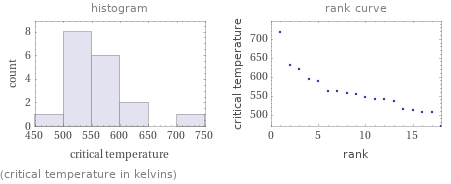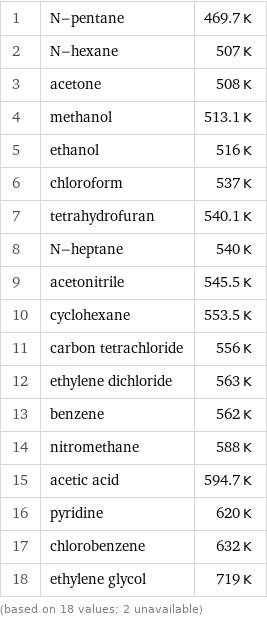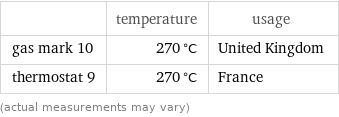Input interpretation

organic solvents | critical temperature
Summary

median | 549.5 K highest | 719 K (ethylene glycol) lowest | 469.7 K (N-pentane) distribution | | (based on 18 values; 2 unavailable)
Entities with missing values

hexamethylphosphoric triamide | dimethyl sulfoxide (total: 2)
Distribution plots

(critical temperature in kelvins)
Critical temperature rankings

1 | N-pentane | 469.7 K 2 | N-hexane | 507 K 3 | acetone | 508 K 4 | methanol | 513.1 K 5 | ethanol | 516 K 6 | chloroform | 537 K 7 | tetrahydrofuran | 540.1 K 8 | N-heptane | 540 K 9 | acetonitrile | 545.5 K 10 | cyclohexane | 553.5 K 11 | carbon tetrachloride | 556 K 12 | ethylene dichloride | 563 K 13 | benzene | 562 K 14 | nitromethane | 588 K 15 | acetic acid | 594.7 K 16 | pyridine | 620 K 17 | chlorobenzene | 632 K 18 | ethylene glycol | 719 K (based on 18 values; 2 unavailable)
Unit conversions for median critical temperature 549.5 K

276.3 °C (degrees Celsius)

529.4 °F (degrees Fahrenheit)

989.1 °R (degrees Rankine)

221.1 °Ré (degrees Réaumur)

152.6 °Rø (degrees Rømer)
Comparison for median critical temperature 549.5 K

51.1 K below melting point of lead (327.46 °C)

43.6 K above autoignition temperature of book paper in Ray Bradbury's famous novel (451 °F)

(30 to 60) K above autoignition temperature of paper (218 to 246 °C)
Corresponding quantities

Thermodynamic energy E from E = kT: | 47 meV (millielectronvolts)

Blackbody energy flux Φ from Φ = σT^4: | 5170 W/m^2 (watts per square meter)

Approximate luminous exitance from a planar blackbody radiator perpendicular to its surface: | 7.2×10^-8 lx (lux)
Nearest corresponding gas marks for median critical temperature 549.5 K (kelvins)

| temperature | usage gas mark 10 | 270 °C | United Kingdom thermostat 9 | 270 °C | France (actual measurements may vary)